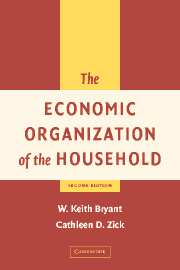Book contents
- Frontmatter
- Contents
- List of Figures
- Preface to the Second Edition
- 1 Introduction
- 2 Household Equilibrium
- 3 The Analysis of Consumer Demand
- 4 Consumption and Saving
- 5 Work and Leisure : How the Household Spends Its Time
- 6 Human Capital : Investing in Oneself and One's Family
- 7 The Economics of Fertility
- 8 The Economics of Marriage and Divorce
- References
- Index
2 - Household Equilibrium
Published online by Cambridge University Press: 06 July 2010
- Frontmatter
- Contents
- List of Figures
- Preface to the Second Edition
- 1 Introduction
- 2 Household Equilibrium
- 3 The Analysis of Consumer Demand
- 4 Consumption and Saving
- 5 Work and Leisure : How the Household Spends Its Time
- 6 Human Capital : Investing in Oneself and One's Family
- 7 The Economics of Fertility
- 8 The Economics of Marriage and Divorce
- References
- Index
Summary
INTRODUCTION
We are now ready to begin the economic analysis of the household. This chapter is devoted to developing the basic economic model of the household that underlies the remaining discussion. The model is set up to analyze the household's demand for goods and services, which will prepare for the discussion in Chapter 3. The model abstracts from the many household attributes and environmental factors, concentrating on two important attributes: (1) the set of goods and services the household can afford, given its income and market prices, and (2) the goals of the household expressed in terms of the preferences it has for goods. The former attribute – what the household can have – is described by the household's budget constraint; the latter – its goals – is described by the household's preference map and utility function. We discuss each in turn. To add concreteness to the analysis we will use food as an example. Hence, we are interested in developing a model of the household that will allow us to analyze the demand for food. The analysis will be general, however, and applicable to the demand for any good.
THE BUDGET CONSTRAINT
In each period (say, a year) we suppose the household to enter the marketplace to purchase those quantities of food and other goods and services that will maximize the family's satisfaction. In doing so it faces market prices for food and other things along with the limited income it possesses.
- Type
- Chapter
- Information
- The Economic Organization of the Household , pp. 8 - 33Publisher: Cambridge University PressPrint publication year: 2005



